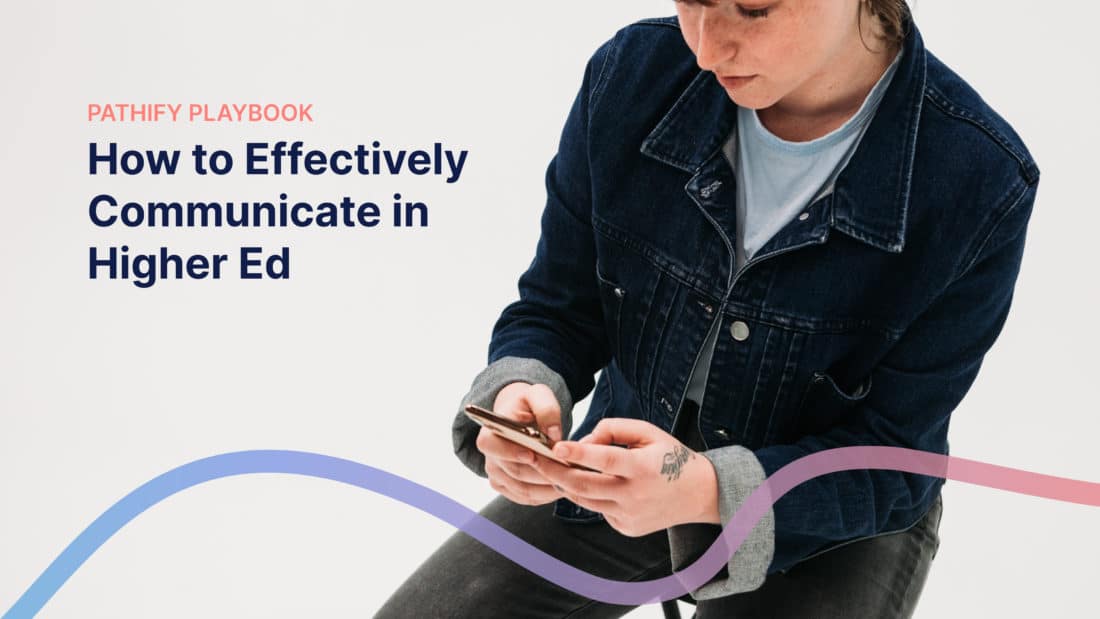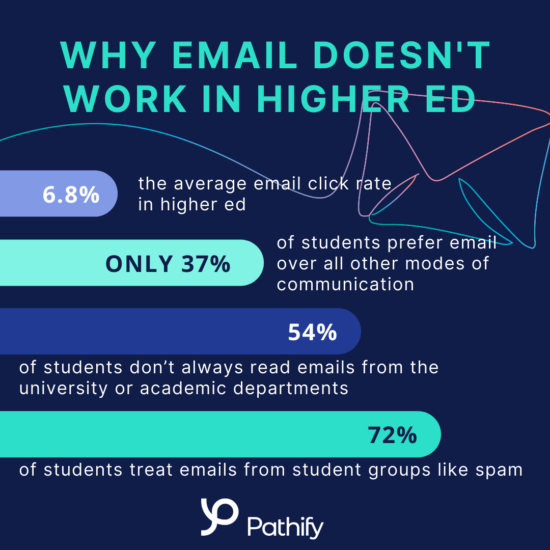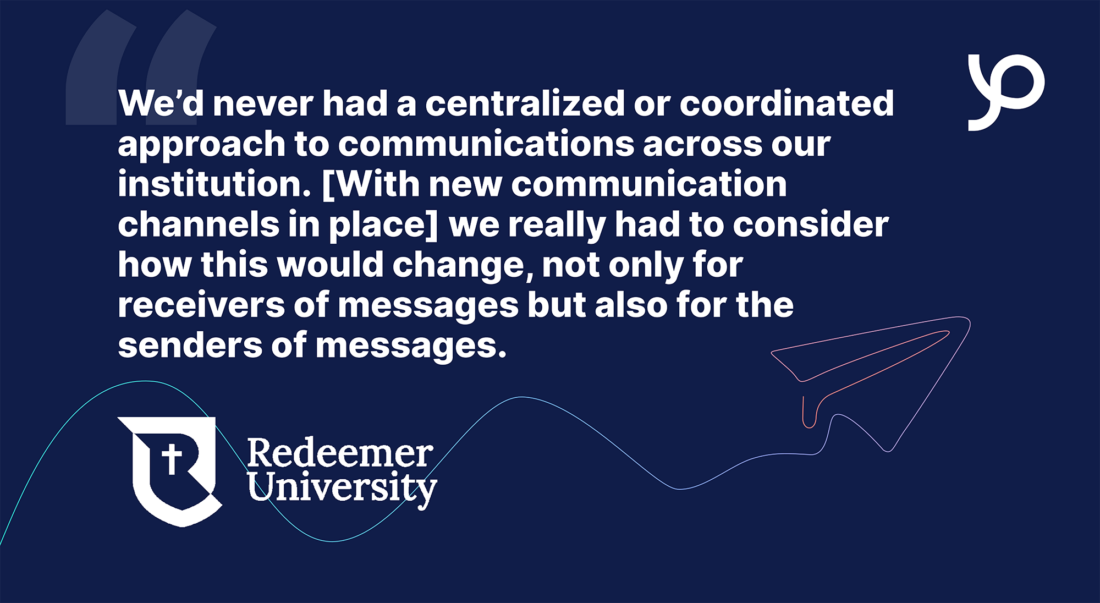Pathify Playbook
How to Effectively Communicate in Higher Ed

Every higher education institution relies on communication to share important information. Unfortunately, effective communication is less common. Many institutions find themselves struggling with common communication challenges. This playbook addresses those challenges and shares some ways to overcome them to create an effective communication strategy.
What You’ll Learn
- The challenges surrounding communications in higher ed today
- How to combat those challenges for successful communication
- Additional tips to help you succeed in the long run
The Challenges
Why effective communication is so hard
In our information overloaded world, capturing a student’s attention to share vital information is a perennial challenge. In a higher education setting, you’re competing against personal communication, social media and online entertainment as well as communications from other departments, clubs, jobs, etc. It’s a noisy space that can be hard to break through, presenting a mulit-faceted challenge when it comes to higher ed communications.
Students use Multiple Devices
Between laptops, desktops, smartphones and tablets, students connect and engage using multiple devices. Educause’s 2020 Student Technology Report found that the majority of students connect two or more devices to campus Wi-Fi daily. Between all these devices, students receive communications in several ways:
- Text message
- Mobile push notifications
- In-platform messaging (announcements, alerts, notifications, etc.)
- Direct message/chat
- Phone calls & voicemails
This makes overall communication more difficult as institutions need to choose the right communication method and medium for each message. Your students are everywhere and you need a way to reach them where they are, when you need to (especially with critical or time sensitive messages). You can’t simply put one communication method in place and expect students to adapt. If you want messages to reach eyes and ears, you need to meet them on their terms.

Staying Relevant
The sheer volume of messages students receive can be overwhelming, especially if you don’t have a strong, institution-wide communication strategy (more on that later). In many cases, your communications will be ignored or opted out of/unsubscribed from completely. Students are used to setting personalized communication preferences in many of the platforms they use daily. They won’t hesitate to treat your communications the same way, especially if you don’t have a personalized communication strategy.
While over communicating is often seen as better than under communicating, it makes it hard for messages to stay relevant. Too many messages desensitizes students to the point where they stop paying attention altogether (especially if the majority of the messages they receive aren’t particularly important).
Email Isn’t Enough
For a long time, email was the holy grail of communication. The sure-fire way to reach the people you needed to reach. While students can technically check email on a computer or mobile device, using email as your primary communication method simply doesn’t cut it these days.
The problem with email is two fold:
- Departments often have their own email systems, which leads to email overload for students
- Today’s students don’t always check email
Email inboxes have simply gotten too flooded to matter to today’s students. Think about the number of promotional emails and irrelevant messages you wade through everyday. It makes the important messages harder to find unless you’re truly dedicated. If you’re relying on email for higher ed communication, important messages are almost certainly being missed.

Email isn’t dead, it also isn’t the only avenue. Have ways to put notifications in front of students in a place they check every hour, not every other day.
Students are Missing Important Messages
While poor communication may seem like an inconvenience, it can have a very serious real-world impact. Ineffective communications mean that students are likely missing important information and messages. This can have major student and institutional ramifications, like dropped enrollment or missed payments.
It’s not that the institution isn’t communicating these messages, it’s that they’re being sent in a way that doesn’t capture student attention. Maybe there are so many message platforms that the student doesn’t know where to look. Maybe they receive so many communications that they’re overwhelmed and tuned out. Or they get the message but don’t act on it right away and subsequently forget about it (that’s where targeted follow ups and personalized tasks come in handy). Either way, ineffective communication can have catastrophic consequences.
“One missed communication can result in a downward spiral that leads to academic consequences. By ignoring critical messages, students on campus are failing to register for courses, declare their major on time, pay tuition, and submit other crucial administrative paperwork.”
— Lindsay Miars, EAB Director
The Solutions
How to make your communication more effective
While communication will likely always be a challenge, there are conscious steps institutions can take to improve the chances of success. Successful communication requires a modern outreach approach and an institution-wide commitment to an overall strategy and standards.
Be Omnichannel
Since students are everywhere, you need to be too. As stated above, a single communication channel won’t lead to effective communication in today’s connected world. To make sure you reach students, you need an omnichannel communications approach. This allows institutions to connect with students wherever they are and via the communication methods that are most likely to resonate with them.
An omnichannel communications strategy should include:
- Email (even though it isn’t totally effective, you shouldn’t abandon it entirely)
- In-app notifications and alerts
- Text (SMS) messages
- Mobile push notifications
- Chat
This allows you to choose the most relevant communication channel for each message and lets students set their communication style preferences (which will make them more likely to pay attention).

31% of students want the ability to text or chat with various offices.
Be Selective
While being omnichannel is important, that doesn’t mean you should send the same message over every platform. In fact, it’s the exact opposite. You should be very purposeful about which channels you use to send which messages. Remember, one of the biggest challenges with communication in higher ed is making sure students don’t get desensitized. Sending all messages over all channels will inevitably lead to burn out where students don’t pay attention to anything anymore.
Highly visible channels like SMS messages, mobile push notifications and alerts should be reserved for only the most important or time-sensitive communications. Everything else should be sent via a more passive channel like email or an in-app notification.
This is one of the hardest rules to master. Everyone thinks their message is high priority. But being selective (and enforcing those decisions) is key to keeping students engaged with communications.
Embrace Personalization
Taking a user-specific personalized approach to communication is another key to not overwhelming students and keeping their engagement. Just like you shouldn’t send every message over every channel, you shouldn’t send every message to every student. Segmentation is nothing new in the email marketing world, and that concept should be extended to all communications institution-wide.
Make sure the messages you’re sending are relevant and helpful to that particular student. Knowing that a message will matter to them is one of the best ways to keep students engaging with your communications. Sending too many “blast” messages signals to the student that the messages likely aren’t very important so there’s no need to pay attention. Ensuring communications are always (or at least mostly) impactful will keep students engaged.
Pathify makes personalized, multichannel communication easy.
Have an Institution-Wide Communication Strategy Define Your Ownership & Admin Plan
One of the best ways to combat communication creep is to have a strong communication strategy. This comprehensive plan should detail all possible marketing communication touchpoints as well as as many anticipated administrative communications as possible.
A good communication plan can help guide successful initiative launches. It’s also key to maintaining control as communication becomes generally easier and more pervasive.
The key to an effective communication strategy is making sure it serves as an umbrella over the entire institution. Too often, each department implements their own communication solutions. While this might work for the departments, it does not create a good student experience — often without faculty, staff or administrators even realizing.
“Every department wants a system that will send out an email and communicate to the students. But what we found was that every department had some sort of email system. It overloaded the students’ mailboxes. We discovered that we had some students receiving over 150 messages a month. Students stopped reading their email. These were less effective messages — the messages weren’t getting acted on and we found that some students missed their financial aid notifications to complete a task and they were at risk of losing their financial aid. Everyone means well to communicate or over communicate with students, but when you have a university of 30 or 40 departments trying to email the same student, it’s overwhelming on the receiving end.”
— Rob Henderson, University of the Pacific
A good communication strategy should serve as an everyday playbook, detailing key metrics like:
- How often messages should be sent
- How to segment communications by relevant users
- Which types of communications may be sent over specific channels
- Institution brand-standards and expectations for communications
- Real-world examples of messages and how they should be sent
A defined strategy is also a chance for marketing teams to get creative. On campus signage, videos and creative giveaways all have a place in a communication strategy and are great ways to capture student attention.
Learn about Utah State University’s creative marketing
Tips for Success
Additional key pointers
Communication is about more than just hitting a “send” button. There are several “behind the scenes” best practices that support overall communication without being about the message itself. Mastering these tips for success is just as important as adjusting your overall approach to direct communication.
Make Information Easy to Find
The trouble with omnichannel communication and the general digitally immersed world we live in is that it can be hard to find the messages you need. While each communication channel is important and has its place, it can also be confusing. To help ease this challenge, make sure information is generally easy to find.
Having a single unified platform where students can check for all types of messages makes it easier for them to revisit a message at a later date without having to remember where they saw it. (This “digital campus” approach also lets you surface important information to students before they even know they need it. While sending an email or notification about wellness services might fall flat, putting helpful information consistently in front of students makes it easy to find if they need it. Passive information communication is just as important as direct communication.)
Having robust search features on all your digital platforms is also helpful, as students will often search for information and answers before reaching out for help. More than 60% of students say they “always” or “usually” use their school’s website to find answers and information, according to The Future of Higher Ed Report 2021, Ivy.ai.
One of the best ways to make information easy to find is by putting it all into one centralized location. See how Pathify helps with that!
Regularly Revisit the Communication Strategy
Having a comprehensive communication strategy does little good if it’s not understood and followed. To prevent this, name one department as the owner of the overall strategy (most likely the marketing and communications department). This department is in charge of maintaining and enforcing the strategy.
As time passes, it’s easy to forget about communication best practices and default to every department doing their own thing. To make sure you don’t fall back into ineffective communication practices, hold regular training sessions so everyone who communicates with students understands how to be effective. (Remember, most departments only think about the messages they send, without realizing every other department a student is involved with is also sending a bunch of messages.)
It’s also important to make sure the strategy is actually working for both the senders and recipients. Before blindly creating a strategy, speak with real students to understand how they’d like to be communicated with and which channels they find most effective. Also meet with several departments, faculty members, professors, advisors and other key institution-level stakeholders to learn about the types of messages they regularly send and what they ultimately want to communicate to students. After the strategy has been in place for a while, revisit with stakeholders to ensure it’s actually working and to see if any adjustments need to be made.
Get Rid of Redundant Solutions
Departments within a university have a habit of implementing their own communications platforms (especially email solutions). This means students may be getting messages from different platforms, creating a frustrating user experience where they need to set preferences multiple times. Overload and frustration can quickly lead to emails being immediately deleted without being opened or blanket unsubscribing regardless of how relevant the message is.
Systems with redundant functionality can also be a drain on precious higher education budgets. If each department has and pays for their own email platform, the institution overall could be overspending on multiple services where a single solution would suffice.
Having a single department oversee the broad communication strategy can help get a handle on systems. IT departments or the technology architect should also be involved to ensure the best solutions are in place and that redundant systems aren’t causing quiet issues in the background.

Summary
Top Takeaways
Communication is the life blood of any higher education institution, but effective communication can be elusive. Communicating with students requires a nuanced, thoughtful approach. If you do nothing else, understanding these top takeaways can reshape the way you think about and approach communication for the better.
Students are overwhelmed
Communication is everywhere these days. The number of communication channels and messages a student deals with everyday can quickly get overwhelming. When students are overwhelmed, they checkout — leaving even the most important message unread.
Being selective about the messages sent, via what channel and how often (institution wide!) is a critical component to effective communication. Not everything is important enough for a text message or push notification. If you treat it like it is, students will tune out.
If it’s not personalized, it doesn’t matter
Too many messages aren’t targeted and personalized. Using general mass communications means the message will be irrelevant to a large portion of recipients. If students get enough of these non-targeted mass messages they’ll start to assume that any new message isn’t worth their time (no matter what it’s actually about). It’s like the story of Chicken Little. Save communications for when it actually matters to that student or what you say will be ignored.
The approach to communication needs to be unified across the institution
An effective communication strategy doesn’t work unless everyone is on board. A few departments that don’t follow best practices can flood students with too often or irrelevant messaging, starting the process over again. Each department and club may think about themselves independently, but to a student, it all falls into the “messages from school” pot.
Creating an institution-wide communication strategy and training everyone on best practices is the best way to keep communication streamlined and effective.
